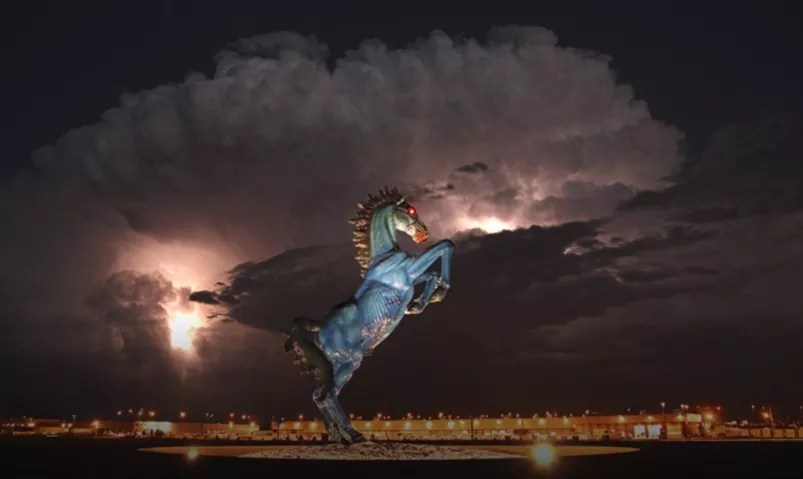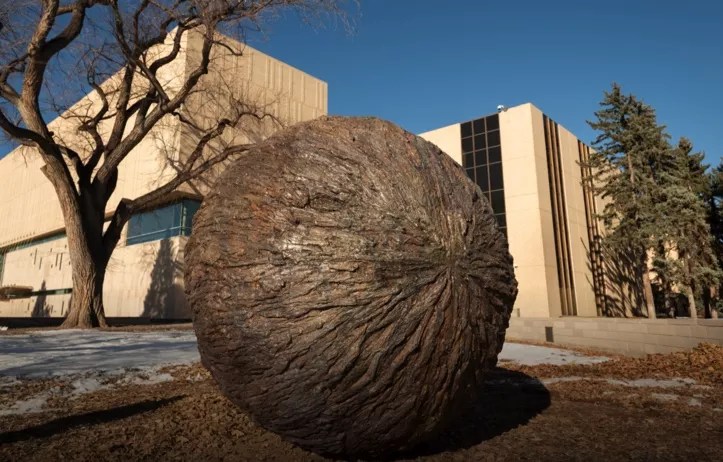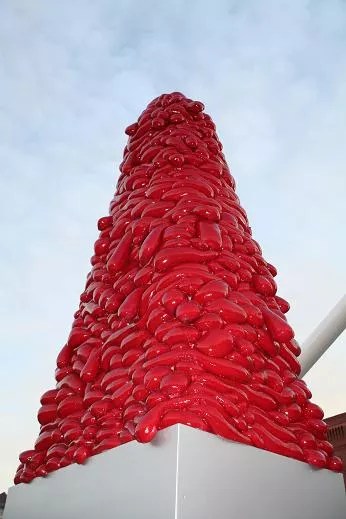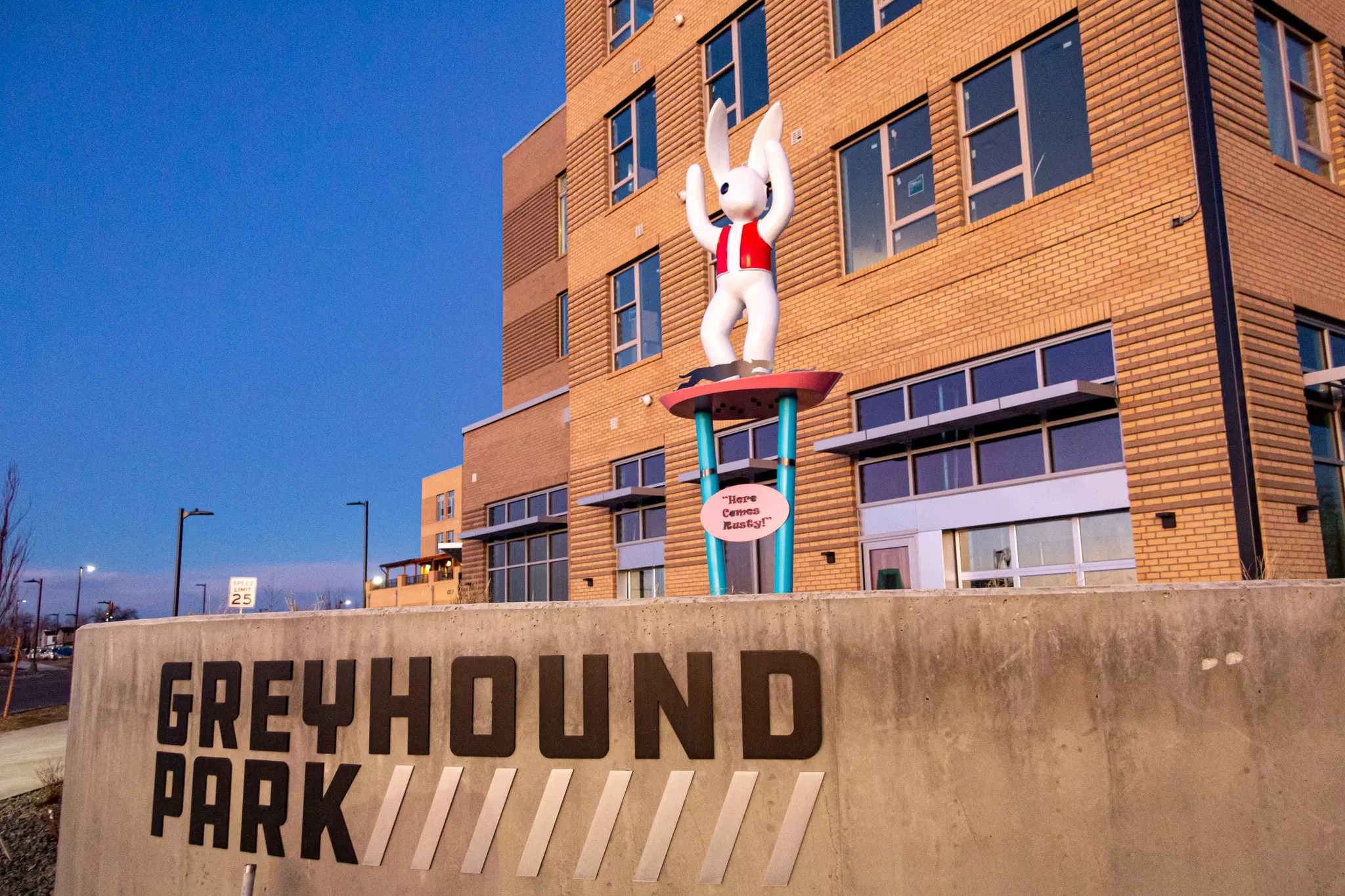
Denver Public Art

Audio By Carbonatix
Denver has plenty of public art, from murals by local legends to sculptures by internationally acclaimed artists. Some works have become so famous that they are almost synonymous with the city, at least for art nerds, such as “The Yearling” or “I See What You Mean,” aka the Big Blue Bear. Others are simply baffling to behold, and a few – most notably “Blue Mustang” – have baffling stories behind them.
Here are six of Denver’s most mysterious works of public art:
“Laughing Escalator”
Colorado Convention Center
Jim Green’s “Laughing Escalator” was installed in the Colorado Convention Center in 2004, and it has unnerved unknowing riders ever since. Using a four-channel sound installation, the escalator that descends into the ballroom pre-function area plays recorded sounds of laughter through the cracks between its steps. According to Denver Public Art, the piece employs “a variety of clear, wholesome voices” for the “open-air mix of sound [that creates] a continually changing pattern of rhythms constructed from laughter.” And when COVID was cutting down on crowds, the sounds could seem particularly ghostly; back then, you’d probably have prefered to take the stairs.
“Rondure”
Denver Museum of Nature & Science

“Rondure”
Denver Public Art
Denver, make your New Year’s Resolution Count!
We’re $12,000 away from reaching our $50,000 year-end fundraising goal. Your support could be what pushes us over the top. If our work has kept you informed and connected this year, please consider making a contribution today.
This seven-foot-tall sphere of bronze looks like it’s waiting for an equally large scarab to push it, and as you approach “Rondure” outside the Denver Museum of Nature & Science, you’ll find it makes noise, too. The motion-activated sound features cries of wildlife found in Colorado, an effect for which artist Nikki Pike collaborated with the bARTer Collective. To the work itself, Pike applied a texture reminiscent of tree bark, which gives the sphere a natural effect that complements its sounds from nature.
“Blucifer”
Denver International Airport
The slightly terrifying, 32-foot-tall blue horse outside Denver International Airport got the nickname “Blucifer” not just for its glowing neon eyes, but for its creation story: Making this sculpture literally killed artist Luis Jiménez. The piece was commissioned for the then-still-unopened airport in 1993; the New Mexico artist was far behind deadline and being sued by the city when he was working in his studio in 2006. That’s when part of the in-progress horse fell on him and killed him; his sons finished the project. The sculpture was inspired by an old Colorado legend about a blue stallion mustang that would lead other horses to water and even fly; the blazing eyes were added as a salute to Jiménez’s father, who owned a neon sign shop. It’s certainly an unforgettable sight for those entering or leaving the city (though we wish people would quit assuming that it symbolizes the Broncos).

“National Velvet”
Denver Public Art
“National Velvet”
Platte Street
John McEnroe’s sculpture near the 16th Street Pedestrian Bridge has garnered controversy ever since it was installed in 2008. The twenty-foot-tall obelisk is made up of what look like melting jelly beans mounded up into an almost Christmas tree-like shape that is highlighted by internal lighting. The sculpture won Denver Public Art’s People’s Choice Award for best public art the year it was installed, but not everyone has been happy about it, with one Westword wag labeling it “Saggy Boob, Electric Penis.”
“Sky Song“
Levitt Pavilion
Artworks such as “Sky Song” come alive only through interaction with their viewers – and sometimes aren’t even recognized as artwork. The installation at Levitt Pavilion by Denver artists Nick Geurts and Ryan Elmendorf does not appear as a traditional sculpture, but its 33 buttons beckon passersby to interact with it and figure out just exactly what it is and does. The eight-foot-tall polished-steel structure and its surroundings are activated by the buttons, which turn on bell and wind chime sounds when the environment is quiet, or cast lights on the amphitheater facade during a concert. It’s easy to miss, but hauntingly strange.

Commerce City Cultural Council Facebook Page
“Here Comes Rusty”
The Landing at Greyhound Park
This newer addition won a Best of Denver award for Best New Public Art in 2023. Anyone old enough to remember the dog races at the Mile High Kennel Club probably remembers Rusty, the mechanical coursing rabbit, and the announcer’s eternal cry of “Here comes Rusty!” The city shut down greyhound racing in 2008, and the track sat empty until Commerce City Urban Renewal bought the land in 2011; redevelopment plans broke ground in 2020. In tribute to the land’s roots, local artists Los Supersónicos (aka Carlos Frésquez and Francisco Zamora) recently installed their rabbit sculpture, “Here Comes Rusty,” at the new Landing at Greyhound Park.